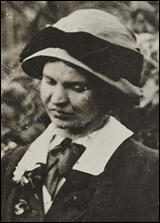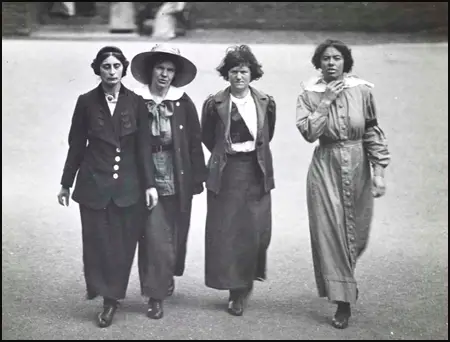Jane Short (Rachel Peace)

Florence Jane Short, was born on 25th April 1881. Her father, Samuel Henry Short, was according to the census, a labourer. He later became a storekeeper for the Metropolitan Board of Works while Jane Short, after leaving school was a shirt machinist but by 1911 she was a masseuse and embroideress in Letchworth. (1)
Short became involved in the Women's Social and Political Union (WSPU) in 1911. Around this time she began using the name Rachel Peace). As Elizabeth Crawford has pointed out: "On occasion women involved in the suffrage movement used aliases, either to protect their family from obloquy by association, or more commonly, in their attempts to evade the police." (2)
The WSPU used a secret group called Young Hot Bloods to carry out acts of violence. It appears Short became a member of this group. No married women were eligible for membership. The existence of the group remained a closely guarded secret until May 1913, when it was uncovered by the conspiracy trial of eight members of the suffragette leadership, including Flora Drummond, Annie Kenney and Rachel Barrett. (3) During the trial, Barrett said: "When we hear of a bomb being thrown we say 'Thank God for that'. If we have any qualms of conscience, it is not because of things that happen, but because of things that have been left undone." (4)
At first she concentrated on breaking windows (Downing Street, November, 1911), Baldock and Hitchen post offices (July 1912) and at an estate agents in Pall Mall (February 1913). After becoming friends with Mary Richardson she became more militant and in October 1913 both women were arrested and charged with burning down the house, "The Elms" at Hampton-on-Thames. (5)
Short was force-fed while on remand to make sure that she was fit to stand trial. Questions were asked in the House of Commons about how this should be allowed, given that she had not yet been found guilty of the crime. "A group of suffragettes smashed windows at her trial to protest at the way she was being treated and were themselves sent to prison; another group tried to set off a bomb at Holloway." (6)
In court it was pointed out that the house was valued at £1,500. A copy of The Suffragette, the WSPU newspaper, was found at the scene of the fire. Short was found guilty and sentenced to 18 months hard labour. (7) Short went on hunger strike but was not released from prison on the terms of the Cat & Mouse Act as she was one of the suffragettes judged likely to re offend and too dangerous to release and so was force-fed for several months." (8)

exercising in the yard of Holloway prison (February 1913)
The WSPU organised several protests against the treatment of Jane Short. This included interrupting church services at St Paul's Cathedral and Westminster Abbey. According to The Times newspaper, Arthur Winnington-Ingram, the Bishop of London, visited Short who told him that because of the force-feeding "I feel as if I should go mad." (9)
While she was in prison Short was able to write secretly to Mary Richardson and Kitty Marion, in pencil using thin brown lavatory paper. Short suffered terribly while serving her prison sentence and endured force-feeding three times a day, causing her to "lose her reason". (10)
On her release from prison she spent the rest of her life in various mental hospitals. She received financial a fellow member of the WSPU, the wealthy Lady Constance Lytton. "Rachel Peace, an embrioderess, suffered terribly while imprisoned. Following prolonged hunger striking and forced feeding three times a day, she 'lost her reason in prison' and spent the rest of her life in and out of asylums." (11)
Lytton raised money to keep Jane in a private asylum and had her to visit when she was well enough. She felt a responsibility for her because at this time the rest of her family were dead. According to Emmeline Pethick-Lawrence that Jane was not an easy person to help. She was "not dangerous but quarrelsome and talkative." (12)
Lytton, who had endured hunger-strikes, was herself in poor health. She wrote to her aunt, Theresa Earle: "If it should happen… I am happy to die. If, as many people believe, we step into a higher life, but are again with loved companions who have died before, then it will be very good. Death to me is like a gentle lover…I am so tired of life, I should like to be taken in his sheltering arms and have an end… I have long hoped to die, and since I've seen this possible road, I have felt most wonderfully happy. Of late years I have seen and felt much of the sad side of death - the separation from those we love. Now I see the joyful side - the release from bodily ills - and it is restful beyond all words." (13)
Lady Constance Lytton died at Knebworth House on 2nd May 1923. Emmeline Pethick-Lawrence suggested that former members of the WSPU should club together in order to care for Jane Short, but according to Lyndsey Jenkins this does not seem to have happened. It is not known when Jane Short died. (14)
Primary Sources
(1) Sylvia Pankhurst, The History of the Women's Suffrage Movement (1931)
On October 5th "The Elms," an unoccupied house at Hampton on Thames, was destroyed by fire, the value being estimated at £1,500. Mary Richardson and Rachel Peace were discovered in the vicinity. They were arrested, hunger struck on remand and were forcibly fed. There were the first women forcibly fed under the "Cat and Mouse" Act...
When Rachel Peace was sentenced, a hammer was flung through a glass screen by a woman in Court, and a juryman cried: "Cannot these women be searched for weapons?
(2) Simon Webb, The Suffragette Bombers: Britain's Forgotten Terrorists (2021)
By 18 December 1913, Rachel Peace, serving 18 months for burning down a mansion in Hampton, was the only suffragette prisoner in Holloway. Peace had been in prison for a month and was currently being force-fed, after embarking on a hunger strike. there was a good deal of anger among members of the WSPU by her treatment.
(3) Kitty Dinshaw, The Birth of Surveillance Photography (20th March, 2018)
Modern day surveillance photography started in Britain in 1913 with an unassuming prison van parked in the exercise yard of Holloway Prison. We only know the occupant of the van as Mr. Barrett, a professional photographer who had been employed by Scotland Yard to snap paparazzi-style shots of the women in the yard. His long-lens photography equipment - the purchase of which was authorised by the then Home Secretary - was rudimentary, but effective.
And who were these women Barrett was photographing? Members of the Women's Social and Political Union (WSPU), also, and perhaps better, known as the suffragettes. Suffrage campaigns were ongoing in both Europe and the United States in the early part of the 20th century, with Finland being the first country to grant women the right to vote and stand for office in 1906.
(4) Lyndsey Jenkins, Lady Constance Lytton: Aristocrat, Suffragette, Martyr (2015)
Constance took on responsibility for the medical care of Rachel Peace. she had been arrested alongside Mary Richardson in October 1913 for arson and had gone on hunger and thirst strike... Rachel was force-fed while on remand to make sure that she was fit to stand trial. Questions were asked in Parliament about how this should be allowed, given that she had not yet been found guilty of the crime. A group of suffragettes smashed windows at her trial to protest at the way she was being treated and were themselves sent to prison; another group tried to set off a bomb at Holloway. Rachel was sentenced to eighteen months' hard labour. Like Kitty, she was one of the suffragettes judged likely to re-offend and too dangerous to release and so was force-fed for several months. The experience had driven her mad. Constance worked tirelessly for rachel, who had no family of her own. She raised money to keep Rachel in a private asylum and had her to visit when she was well enough. This cannot have been easy for Constance, as Rachel was, according to Emmeline Pethick-Lawrence, "not dangerous but quarrelsome and talkative."
(5) The Daily Telegraph (6th February, 2018)
Rachel Peace, an embrioderess, suffered terribly while imprisoned. Following prolonged hunger striking and forced feeding three times a day, she "lost her reason in prison" and spent the rest of her life in and out of asylums. Her case was widely publicised and aristocratic suffragette Lady Constance Lytton, aware of the terrible price she had paid, maintained her until her death.
Student Activities
References
(1) Census Data (1891, 1901, 1911)
(2) Elizabeth Crawford, The Women's Suffrage Movement: A Reference Guide 1866-1928 (2000) page 6
(3) Yorkshire Evening Post (8th May 1913)
(4) Nottingham Evening Post (8th May 1913)
(5) Elizabeth Crawford, The Women's Suffrage Movement: A Reference Guide 1866-1928 (2000) page 597
(6) Lyndsey Jenkins, Lady Constance Lytton: Aristocrat, Suffragette, Martyr (2015) page 212
(7) Simon Webb, The Suffragette Bombers: Britain's Forgotten Terrorists (2021) page 132
(8) Sylvia Pankhurst, The History of the Women's Suffrage Movement (1931) page 496
(9) The Times (17th November 1916)
(10) Diane Atkinson, Rise Up, Women!: The Remarkable Lives of the Suffragettes (2018) pages 439–440
(11) The Daily Telegraph (6th February, 2018)
(12) Emmeline Pethick-Lawrence, letter to Mrs Solomon (13th June, 1923)
(13) Lady Constance Lytton, letter to Theresa Earle (April, 1923)
(14) Lyndsey Jenkins, Lady Constance Lytton: Aristocrat, Suffragette, Martyr (2015) page 233

